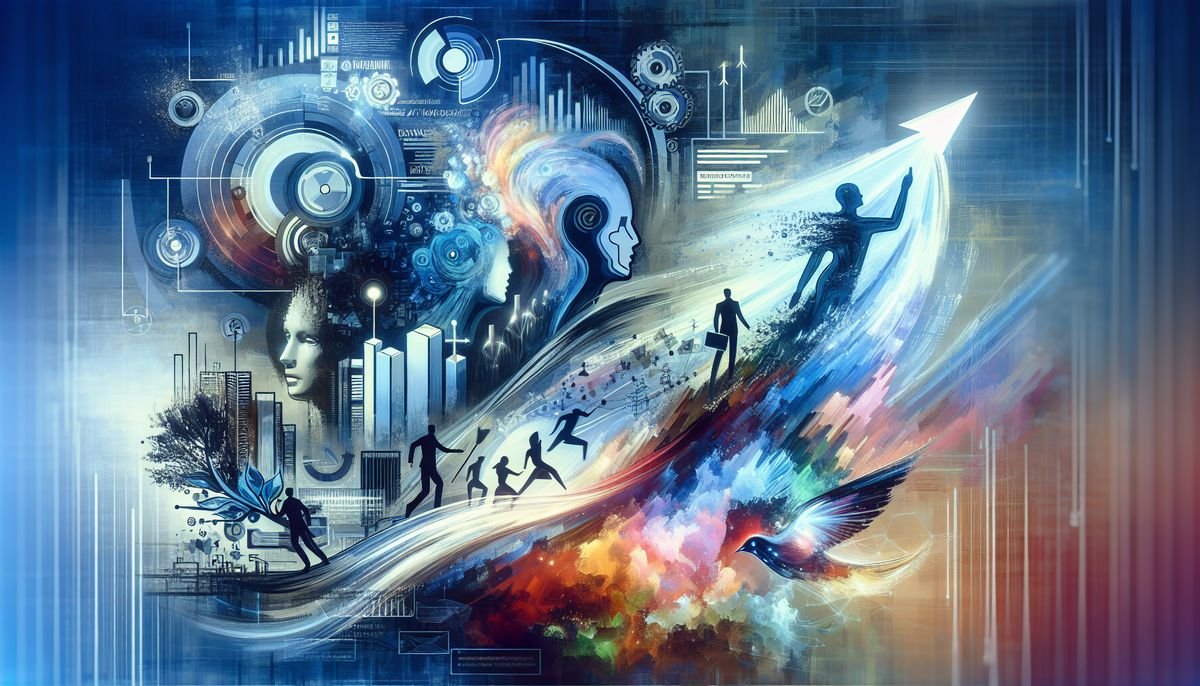The technological landscape is continuously reshaped by innovations in artificial intelligence, particularly with the advent of visual AI tools like Stable Diffusion. This groundbreaking technology is not only redefining the boundaries of digital art creation but is also carving out new avenues for business applications. In this article, we explore the rise of Stable Diffusion, specifically its latest iteration, Stable Diffusion 3, and delve into its impact on enhancing visual content creation and integrating into strategic business processes.
Key Takeaways
- Stable Diffusion 3 offers businesses a cutting-edge tool for generating high-quality, customizable visual content, streamlining marketing, and enhancing customer experiences.
- The technology’s open-source model democratizes access to AI, enabling a wide range of businesses to adopt visual AI for competitive analysis and market research.
- Combining human creativity with Stable Diffusion’s AI capabilities can lead to the production of impactful visual assets and strategic insights that drive business growth.
Harnessing Stable Diffusion for Enhanced Visual Content Creation
Understanding the Mechanics of Stable Diffusion 3
Stable Diffusion 3 represents the cutting-edge in visual AI, particularly in the realm of text-to-image synthesis. At its core, the model operates on a latent diffusion approach combined with a Multimodal Diffusion Transformer architecture. This sophisticated framework allows for the generation of high-quality images from textual descriptions, encoding text prompts into visual representations with remarkable accuracy and detail.
The model’s prowess is underpinned by its training on a subset of the LAION-5B database, specifically on 512×512 images, ensuring a broad and diverse dataset for learning. The architecture of Stable Diffusion 3 is further enhanced by the integration of flow matching techniques, which contribute to the model’s efficiency and effectiveness in generating images conditioned on textual input.
Stable Diffusion 3’s ability to cater to various scalability and quality needs is reflected in its range of models, varying from 800 million to 8 billion parameters.
Understanding the nuances of this technology is crucial for businesses looking to leverage AI for visual content creation. The model’s versatility is evident in its application across different domains, from marketing to customer experience enhancement.
Navigating the Text-to-Image Generation Process
The advent of Stable Diffusion has marked a significant milestone in the field of visual AI, particularly in the realm of text-to-image generation. This open-source model has democratized the ability to create detailed and realistic images from textual descriptions, making it a powerful tool for businesses seeking to enhance their visual content.
The process begins with the analysis of textual descriptions, where the AI employs advanced machine learning algorithms to grasp the context and nuances of the input text. Following this, the image generation phase kicks in, translating the analyzed text into visual representations that can be remarkably lifelike and intricate.
To refine the output, users can interact with the generated images, making adjustments to produce variations, edit details, or even use the image as a foundation for further creations. This iterative process allows for fine-tuning until the desired quality and specificity are achieved.
The flexibility and accessibility of Stable Diffusion have made it a go-to solution for businesses looking to quickly generate bespoke visual content without the need for extensive resources or specialized skills.
Maximizing Image Quality with Advanced Techniques
In the realm of visual AI, image quality is paramount. Businesses leveraging Stable Diffusion for content creation are increasingly turning to AI image upscalers to enhance the resolution and detail of generated images. Upscalers like ESRGAN have become indispensable, seamlessly integrating with Stable Diffusion’s workflow to produce images that are not only creative but also crisp and highly detailed.
To upscale images effectively, users can access the WebUI’s "Extras" tab. The process is straightforward: upload the image, select the desired output size, and choose an upscaler. It’s crucial to maintain the aspect ratio to avoid distortion. Here’s a simple guide:
- Upload the image to the "Extras" tab.
- Choose the output size using the "Resize" slider.
- Select an AI image upscaler like ESRGAN.
- Ensure the aspect ratio is correct.
- Uncheck "Crop to Fit" if necessary.
By fine-tuning additional elements such as resolution, color, and lighting, businesses can guide Stable Diffusion to create images that align perfectly with their branding and aesthetic goals. The ability to add cinematic lighting or specific color tones can transform a standard image into a visually compelling piece.
As Stable Diffusion continues to evolve, we can anticipate more sophisticated editing tools that will further simplify the creation of high-quality visual content. This progression will undoubtedly empower businesses to produce ultrarealistic imagery with greater ease and precision.
Integrating Stable Diffusion into Business Strategies
Revolutionizing Marketing with AI-Generated Imagery
The advent of AI-generated imagery has opened a new chapter in the realm of marketing, providing a fresh palette for creative expression and communication. Businesses are now harnessing the power of Stable Diffusion to craft captivating images that resonate with their target audience, transcending traditional marketing boundaries.
One of the most significant advantages of AI-generated visuals is their ability to spark new ideas and overcome creative blocks. Marketers can now generate a plethora of visual concepts quickly, which can then be refined with human expertise to ensure they align with brand values and campaign goals.
The synergy between human creativity and AI’s generative capabilities is fostering an evolving landscape of advertising that is both innovative and effective.
Utilizing Stable Diffusion, companies can create hyper-realistic and engaging content for various applications, from social media campaigns to digital billboards. This not only enhances the visual appeal of advertisements but also enables personalized and multilingual messaging, reaching a broader audience.
Here are some key points to consider when integrating AI-generated imagery into marketing strategies:
- Combining human judgment with AI to create impactful visuals
- Leveraging AI to generate diverse visual concepts
- Refining AI-generated images to align with brand values
- Using AI to create personalized and multilingual visuals for broader reach
Optimizing Customer Experience through Visual AI
In the dynamic landscape of retail, AI technologies are becoming pivotal in enhancing customer engagement and experience. By integrating machine learning for customer personalization, businesses can analyze consumer behavior to offer highly tailored interactions. This not only fosters brand loyalty but also encourages repeat business.
The recent trend of using AI-powered visual search tools has been particularly transformative. These tools allow customers to upload images to find or match products, significantly shortening the customer journey and personalizing recommendations. For instance, Miros.ai emphasizes the importance of using AI to personalize recommendations and streamline the customer experience.
Moreover, AI-enabled customer service, as highlighted by Appinventiv, is revolutionizing business operations. It unlocks significant value for users, creating a virtuous circle of enhanced service and customer satisfaction. The table below illustrates the impact of AI on customer experience metrics over the past quarter:
| Metric | Q1 2023 | Q2 2023 | Change |
|---|---|---|---|
| Customer Satisfaction Score | 82% | 87% | +5% |
| Repeat Purchase Rate | 30% | 35% | +5% |
| Average Resolution Time | 12h | 10h | -2h |
The synergy between AI and human creativity is essential. While AI generates diverse visual concepts, human judgment refines them, leading to impactful and effective visuals that resonate with consumers.
Exploring the Future of AI in Competitive Analysis and Market Research
The landscape of competitive analysis and market research is being reshaped by artificial intelligence, offering businesses unprecedented strategic insights. AI is not just a tool for efficiency; it’s a strategic asset that can provide a significant competitive advantage. By leveraging AI, companies can perform detailed competitive analyses and identify market opportunities with a level of precision that was once exclusive to industry giants.
Recent trends show a surge in the adoption of AI tools for competitor analysis. For instance, the title: Top 10 AI Tools for Competitor Analysis in 2024 | ClickUp, highlights the importance of staying informed about the latest AI technologies to maintain a competitive edge. These tools enable businesses to craft heat maps, conduct in-depth market evaluations, and predict trends, all while operating independently.
The transformative potential of AI extends beyond content generation, encompassing strategic business transformation. It’s about harnessing the power of AI to uncover market opportunities and craft strategies that can dramatically alter a company’s trajectory.
Retailers adopting AI technologies not only streamline operations but also distinguish their brand from competitors. Staying ahead of tech trends is crucial for capturing the attention of tech-savvy shoppers and positioning a brand as a leader in innovation. As we look to the future, the integration of AI in competitive analysis and market research will continue to be a key differentiator for businesses seeking to thrive in an ever-evolving marketplace.
Conclusion
Stable Diffusion has emerged as a transformative force in the realm of visual AI, offering creative professionals and businesses an unprecedented tool for generating high-quality images and videos. As we’ve explored, its applications range from enhancing marketing campaigns to revolutionizing customer support automation. The technology’s ability to democratize access to AI-driven visual content creation, as exemplified by the open-source Stable Diffusion 3, underscores a future where human creativity is augmented by AI, not replaced. Embracing this evolving landscape with a responsible and ethical approach will be key to harnessing its full potential. As AI continues to advance, it is imperative for businesses to integrate these innovations strategically, not just for efficiency, but to unlock new opportunities and drive transformation in their industries.
Frequently Asked Questions
What is Stable Diffusion and how can it benefit my business?
Stable Diffusion is a text-to-image AI model that enables the creation of high-quality images from textual descriptions. It can benefit businesses by enhancing visual content creation for marketing, automating customer support with visual aids, and providing insights in market research through visual data analysis.
How does Stable Diffusion 3 differ from previous versions?
Stable Diffusion 3 is the latest version that improves upon previous models by offering higher image quality and faster processing times. It leverages a latent diffusion model trained on a subset of the LAION-5B database and is designed to democratize access to AI technologies by being open source.
Can Stable Diffusion be integrated into existing business workflows?
Yes, Stable Diffusion can be integrated into business workflows either through an API on local machines or via online software programs. It can assist in generating diverse visual concepts, automating content creation, and enhancing customer experiences with visual interactivity.



